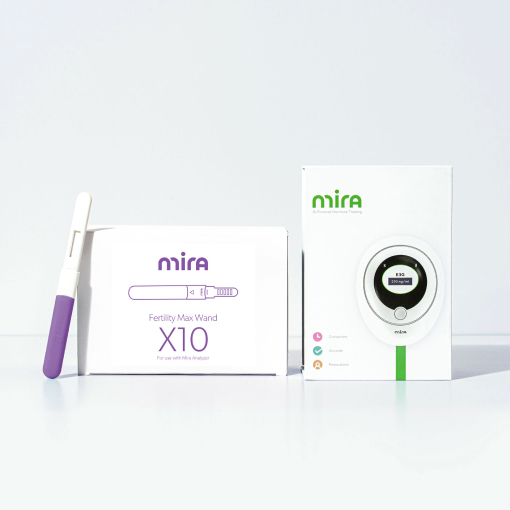LGBTQ+ Fertility Options for Transgender & Gay Couples
Families come in all shapes and sizes and there are many roads that lead to parenthood. The options for becoming a parent for members of the LGBTQ+ community may have some unique needs but thankfully there are more choices available than ever before. Whether you are gay, lesbian, transgender, or any other orientation, choosing which family-building process is right for you can be a monumental task.

There may be some logistical, financial, or legal hurdles to overcome but they shouldn’t prevent or stop you from becoming a parent. In this post we will provide a basic understanding of some of the LGBT fertility options available and how they work. Read on to learn more about family-building opportunities and which one might work for you.
The aim of this article is purely educational. Mira is not designed to monitor any fertility treatment. Please always refer to your healthcare provider.
Understanding Your Fertility Options
The following technologies are available to assist couples looking to build their family.
IVF
In-vitro fertilization, or IVF, is a type of assisted reproductive technology that involves a fertilized egg, or embryo, being transferred to a woman’s uterus. IVF cycles involve diagnostic testing, ovarian stimulation, egg retrieval, egg fertilization, and then transfer of the embryo into the uterus.
Once the eggs are retrieved they are fertilized in a lab setting with fresh or frozen sperm before being transferred to the uterus. One or more embryos may be transferred with the hopes that at least one will implant and result in pregnancy.
IUI
Intrauterine insemination (IUI) is when sperm is inserted directly into the woman’s uterus in the hopes that it will reach the egg and result in pregnancy. The sperm in this procedure are given special treatment and are “washed” and concentrated before being inserted directly into the uterus.
Fertility medications may be used to support ovulation and implantation, but are not always necessary. IUI is less expensive and invasive than IVF and many couples try this procedure as a first step.
Sperm donor
Many would-be parents may need to use a sperm donor for a variety of reasons. Finding a sperm sample can be done through a sperm bank, an agency for anonymous donors, or you may have the option of using sperm from a friend. No matter the source, routine medical screenings are recommended before insemination takes place and there may be legal agreements to arrange. Insemination can take place with the assistance of a fertility clinic or may even be done at home for a known donor.
Egg freezing
The process for egg freezing is similar to an IVF cycle and involves hormone injections to stimulate the ovaries, blood work and ultrasounds, before eventual harvesting. Once harvested, eggs are frozen and stored until a patient chooses how to use them in the future. There may be a variety of reasons for choosing this option including a cancer diagnosis, declining ovarian function, or simply taking advantage of optimal egg viability.
Surrogacy
For those same sex pregnancies where one partner cannot carry their own child, surrogacy is an option. Surrogacy allows couples to have a genetically related child of their own, even if they cannot physically carry the child in pregnancy. Surrogacy involves an embryo created through IVF being transferred to the uterus of the surrogate for implantation. The surrogate will carry the baby for the duration of the pregnancy until birth. There are important factors to take into consideration when it comes to surrogacy including legal agreements and local laws.
Egg donation
Some would-be parents may require egg donation to achieve an LGBT pregnancy. In this procedure, eggs are harvested from one woman to be transferred into the uterus of another woman. Egg donation may be needed for women with egg quality or other health issues, or by men or transgender individuals looking to start a family. Whether you choose an anonymous or known donor, the process is similar to IVF and success rates can vary significantly due to the factors involved.
Adoption
Many LGBT parents build their families through adoption. While some people are under the misconception that trans people or same sex couples can’t adopt, this is untrue. There are many paths to adoption and couples can either work with an agency, government program, or pursue international options. Every adoption process is unique and will depend on the resources available to you.
LGBT Fertility Options
Assistive reproductive technologies have given the LGBT community more options than ever to achieve the dream of building a family. Lesbian, gay, and transgender couples all face different challenges and prospective parents need to evaluate which family planning option that is right for them. Biological challenges aside, there are a variety of paths LGBT families can take on their journey to parenthood.
Lesbian Couples
Female same-sex couples can use the same paths to pregnancy as different-sex couples, though it will depend on personal preferences and medical history. Unless you plan to have sex with a male, you will likely need to use assistive reproductive technologies (more on pregnancy options for lesbians here).
Potential options
Thanks to biology, female same-sex couples have a number of different options available to them. Couples can work with their physician to see which of the following options make the most sense.
1. Intrauterine insemination (IUI)
The simplest and least expensive option, IUI can be done with or without fertility drugs and involves one partner undergoing a form of artificial insemination to achieve pregnancy. One or both partners can experience pregnancy with IUI and it is usually one of the first fertility treatment options for lesbian couples with a desire to conceive and carry. Although there are many variables, success rates for this procedure are between 10-20% and a 2014 study found that these rates were comparable to those of hetersexual women.
2. In vitro insemination (IVF)
Often the next step from IUI, this option requires more robust medical interventions such as hormone injections to stimulate the ovaries and medical procedures for egg retrieval and insemination. Lesbians having a baby through IVF can use their own eggs or donor eggs.
There are a number of considerations to take into account when looking at IVF for same sex pregnancies. The costs associated with IVF are higher than other procedures and may not be covered by insurance. Success rates vary greatly and will depend on your personal factors such as age and health status.
3. Adoption or fostering
If being biologically related to your child isn’t necessary, adoption or fostering can be a way for you to grow your family. Many children need placement and this option is especially attractive if you are open to older children or those with special needs. The public child welfare system can be an avenue for adoption that involves less expense and helps place especially needy children.
Private and international adoption are also an avenue, but involve additional costs that can add up fast. While expensive, this option allows you to work through a private agency and gives you more control over the child you adopt. Fees vary greatly and will depend on your specific situation and how far you need to travel.
Fostering is a way to provide meaningful, but usually temporary, care to a child with the goal of reuniting them with their own family. The length and time of the placement will vary by case, but this can be a rewarding way to provide structure and love for a child, even if it’s not what you originally had in mind.

How it might work
Lesbians looking to proceed with any of these scenarios will first need to take some things into consideration. For biological family building you’ll need to consider the medical implications, your fertility health, and cost. Your doctor will likely start with a basic fertility workup before any decisions can be made. Time is also a factor and if you are of an advanced maternal age you may want to consider the fastest path to parenthood.
Gay Couples
Although it may take a little more preparation, there are still many options for gay men who wish to become parents. Gay couples can use assistive reproductive technologies to have a biologically related child or can make use of donors and other options like surrogacy to achieve their dreams of parenthood.
Potential options
Since they are unable to carry the baby on their own, male same-sex couples will need to look into other options for gay impregnation.
1. Surrogacy
Through either traditional or gestational surrogacy, gay men can become parents by having a woman carry the pregnancy for them. Traditional surrogacy involves the woman donating both her egg and uterus for insemination. One of the biological father’s sperm will be used so there is a biological link to the child, but given the legal complications this option can present, it has become less popular. Gestational surrogacy offers fewer of these legal complications since an egg donor will be used instead of her egg.
Through traditional IVF, the surrogate will be inseminated with the donor embryo in the hopes of impregnation. If implantation is successful, the surrogate carries the baby until birth whereby the couple would then keep the baby. The legal considerations for surrogacy are vast and you should work with a reputable agency and lawyer to determine what’s right for your situation.
2. Adoption
Gay couples can choose to build their families through adoption and there are many paths to achieving parenthood in this way. Whether through public or private adoption, the process can be complex and often requires the help of a professional. Details vary based on jurisdiction, but navigating this journey to parenthood can take a lot of planning and preparation before a child will be placed in your home.
How it might work
Surrogacy and adoption both involve complex steps with legal ramifications. Because of the legal aspects these options present, couples usually work with organizations or agencies to arrange them.
Regardless of which option you pursue, you’ll need both time and resources to navigate the process. From finding a surrogate, to filling in the mountain of paperwork that comes with adoption, these options can involve many steps to ultimately lead to parenthood. When it comes to surrogacy and adoption for gay pregnancy, time and mental reslience should also be taken into consideration. Taking all the steps to successfully become parents in this way is no small effort, and although worthwhile, is a significant undertaking for any couple.
Transgender Options
Transgender individuals or couples have a number of options available to them for family-building now or in the future. Prior to any gender-affirming surgery, eggs and sperm can be frozen and stored for later use to give the option of having genetically related children. And although there may be additional challenges, you still have options. Working with a fertility specialist well-versed in transgender care can help narrow down what is available to you.
Potential options
Both trans men and trans women need to stop hormone therapy if they wish to begin reproduction. Returning to fertility is variable and you will work closely with your physician to guide you through these circumstances.
Trans women’s options include:
- In vitro fertilization
- Sperm freezing
- Partner or donor eggs
- Gestational carriers
Trans men have the option of:
- Egg and/or embryo freezing
- Donor sperm
- Undergoing IUI or IVF
How it might work
Although research is ongoing, much work remains to be done in the area of transgender fertility. Consulting a fertility specialist with knowledge in transgender care is key for anyone looking to explore their options. When you are ready to start your fertility journey, they will be able to figure out your unique needs to achieve parenthood.
Recommended for you
Navigate your fertility with peace of mind
Mira’s Editorial Process
All content produced by Mira meets stringent editorial standards, ensuring excellence and accuracy in language and medical precision. Every piece undergoes thorough fact-checking and review by qualified professionals. Check out our full editorial process to learn more.














